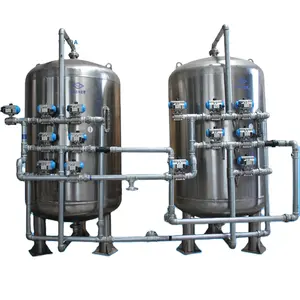A pool sand filter is a filtration system used in swimming pools to remove impurities and debris from the water. It consists of a large tank filled with specially graded sand as the filtration medium.
Uses and Benefits of a Pool Sand Filter
A sand pool filter removes contaminants, such as dirt, leaves, grass, insects, hair, oils, and bacteria, from the pool water. This filtration helps improve water clarity and prevent the growth of algae and other harmful microorganisms. The pool filter system is crucial in circulating the pool water. As the water is drawn into the filter, it is pumped through the sand bed and returned to the pool. This constant circulation helps to distribute chemicals evenly, maintain a consistent temperature, and prevent stagnant areas in the pool. A properly functioning sand filter aids in maintaining the chemical balance of the pool water. Removing contaminants reduces the load on other pool equipment, such as pumps and heaters, and allows chemicals like chlorine to work more effectively.
Features of a Pool Sand Filter
The pool filtration system tank is made of durable materials such as fiberglass or reinforced plastic. It is designed to withstand the pressure of the water and the sand bed inside. The tank is usually cylindrical and has a top-mounted or side-mounted valve for water flow control. The pool filter tank is filled with specially graded sand as the filtration medium. The sand bed acts as a physical barrier that traps and removes impurities from the water as it flows through. The sand is fine enough to capture small particles but coarse enough to allow water to pass through without excessive resistance.
The multiport valve, also known as the control valve, is located on top of the filter tank. It is called a multiport valve because it has multiple ports inside it that allow the water to move in multiple directions. It allows for various functions and control settings, such as filtering, backwashing, rinsing, recirculating, and closing of the water flow.
A pressure gauge is installed on the filter tank to monitor the pressure inside. It visually indicates when the filter needs to be backwashed or cleaned. As the filter becomes clogged with debris, the pressure gauge reading will increase, signaling the need for maintenance. A backwash system is used to clean the filter and remove trapped debris. Backwashing involves reversing water flow through the filter and flushing out the accumulated dirt and debris. The backwash system is activated through the multiport valve, which redirects the water flow accordingly.
How Does a Pool Sand Filter Work?
A pool sand filter is connected to a pool's circulation system through a pump. The filter captures and removes impurities and debris, trapping particles such as dirt, leaves, grass, insects, hair, oils, and bacteria. The filtered water then returns to the pool through the return jets. Over time, the sand bed becomes clogged with trapped debris, which reduces its filtration efficiency. The backwash process cleans the filter by reversing the water flow through the filter and flushing out the accumulated dirt and debris.











































 浙公网安备 33010002000092号
浙公网安备 33010002000092号 浙B2-20120091-4
浙B2-20120091-4